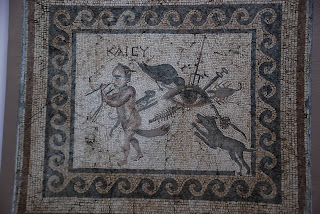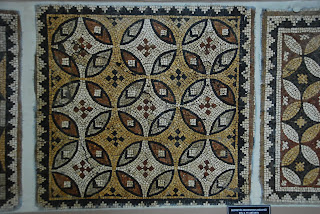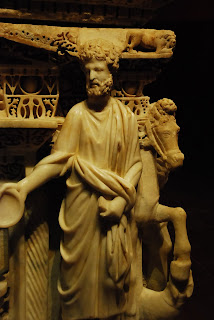Antakya, Tuesday, October 27
17,350 km from Xian
I made it!!! I rode into Antakya today at midday, outrunning a massive thunderstorm, arriving in what was once Antioch, the third-largest city in the Roman Empire and (more importantly) the western terminus of the cross-Asia caravan routes known as the Silk Road. The Silk Road has been cycled!
Now, it's true that Antioch declined from its apex after its harbour and river silted up, after a disastrous series of wars with the Sassanid Persians, and especially after a number of catastrophic earthquakes around AD 526. After that point, Antioch lost its pre-eminence and trading importance. While a bale of Chinese silk would have likely made its way overland to Antioch in the first century AD before being loaded onto a ship, by the time of Marco Polo (the 13th century) it would more likely have made its way either to Alexandretta (now called Iskenderun) or to Ayas, both ports with strong Genoese and Venetian trading presences. So, just
with strong Genoese and Venetian trading presences. So, just  to cover my historical bases, I am not stopping the bike ride here. Tomorrow I will ride out to the old port of Antioch (the city itself is some distance up the Orontes River from the Med), then continue up the coast to the old Armenian kingdom of Cilicia, where Ayas (modern Yumurtalik) is located. Ayas will be the last port of call for this bike odyssey.
to cover my historical bases, I am not stopping the bike ride here. Tomorrow I will ride out to the old port of Antioch (the city itself is some distance up the Orontes River from the Med), then continue up the coast to the old Armenian kingdom of Cilicia, where Ayas (modern Yumurtalik) is located. Ayas will be the last port of call for this bike odyssey.
The ride to get here, three days from Gaziantep, was almost anticlimactic. Very little climbing, kind of non-descript scenery, not too much to look at. The first day I rode south to Kilis, eulogized in the Lonely Planet as a must-see repository of historic architecture. Maybe I didn't
 find the interesting bits, but it was as modern and anodyne a city as you could imagine, and I stayed only as long as it took to order a take-out doner kebab. I camped in a reforested grove of pine trees that night and slept well.
find the interesting bits, but it was as modern and anodyne a city as you could imagine, and I stayed only as long as it took to order a take-out doner kebab. I camped in a reforested grove of pine trees that night and slept well.
Yesterday I pushed on, through a very Mediterranean landscape of olive groves that could easily have been in Spain, Greece, Tunisia or Italy. The historic interest of the day was the Hittite sculpture workshop at Yesemek, where big blocks of black basalt were shaped and roughly


 carved before being shipped to their final destination to be finished and polished. Lots of half-finished sphinxes, lions and mountain gods, with one enigmatic bear-man thrown in for good measure. The Hittites (1500-1150 BC) are one of the oldest civilizations whose traces I've run across on this trip. I pushed on, following a river valley downhill towards Antakya before camping in an olive grove. My sleep that evening, however, was badly interrupted by a series of spectacular thunderstorms, my tent fly leaking in the worst of the explosive downpour, and a small river flowing right under my tent and soaking me from beneath.
carved before being shipped to their final destination to be finished and polished. Lots of half-finished sphinxes, lions and mountain gods, with one enigmatic bear-man thrown in for good measure. The Hittites (1500-1150 BC) are one of the oldest civilizations whose traces I've run across on this trip. I pushed on, following a river valley downhill towards Antakya before camping in an olive grove. My sleep that evening, however, was badly interrupted by a series of spectacular thunderstorms, my tent fly leaking in the worst of the explosive downpour, and a small river flowing right under my tent and soaking me from beneath.

 I awoke groggy this morning, but the prospect of making it to the end of the Silk Road got me going, as did the downhill and tailwind. I flew along into town, found a hotel, decorated its outside with my laundry and my bicycle, and set off to see more Roman mosaics at the museum. Unlike at the Gaziantep museum, these mosaics came from a variety of sites in the Antakya area rather than from one spot. Some of the workmanship and composition was spectacular, but the mosaics as a whole were far more heavily damaged than the Antep ones, making for less of a wow effect. It is still, however, one of the world's best collections of Roman and Byzantine mosaics anywhere, and I walked out pretty happy.
I awoke groggy this morning, but the prospect of making it to the end of the Silk Road got me going, as did the downhill and tailwind. I flew along into town, found a hotel, decorated its outside with my laundry and my bicycle, and set off to see more Roman mosaics at the museum. Unlike at the Gaziantep museum, these mosaics came from a variety of sites in the Antakya area rather than from one spot. Some of the workmanship and composition was spectacular, but the mosaics as a whole were far more heavily damaged than the Antep ones, making for less of a wow effect. It is still, however, one of the world's best collections of Roman and Byzantine mosaics anywhere, and I walked out pretty happy.
I strolled through the old town of Antakya, although few old buildings remain, mostly from Ottoman times. There is almost nothing of the physical fabric of the Roman or Byzantine city, or even from the Crusaders (who besieged the town for six months in 1097-98 before taking it and occupying it for over a century). The bazaar area, while extensive, is almost exclusively made of modern buildings with an unfortunate modern metal and plastic roof over the street, making it more of a modern shopping mall than an old-fashioned bazaar. Almost no hand-made goods are for sale these days; cheap plastic mass-produced junk (much of it, ironically, from China) is the
mass-produced junk (much of it, ironically, from China) is the  order of the day. In comparison to Isfahan and Shiraz, or nearby Aleppo, it's nothing to write home about. However, the fact that this was where the bales of silk carried across Asia by countless caravans and merchants from Han Dynasty China ended up was consolation for the unremarkable architecture.
order of the day. In comparison to Isfahan and Shiraz, or nearby Aleppo, it's nothing to write home about. However, the fact that this was where the bales of silk carried across Asia by countless caravans and merchants from Han Dynasty China ended up was consolation for the unremarkable architecture.
 Antioch is also a major city in the history of Christianity. St. Luke is said to have come from Antioch, and Saints Paul and Peter both spent a lot of time here. Antioch had a huge Jewish population, and it was here that the new sect first prospered. I rode out to a cave that was supposedly used as the first Christian church, but was put off by the 8 TL admission charge so I looked at it from the outside, then went back to town to scarf down the scrumptious local dessert specialty, kunefe, a mixture of shredded wheat, white cheese, pistachios and honey.
Antioch is also a major city in the history of Christianity. St. Luke is said to have come from Antioch, and Saints Paul and Peter both spent a lot of time here. Antioch had a huge Jewish population, and it was here that the new sect first prospered. I rode out to a cave that was supposedly used as the first Christian church, but was put off by the 8 TL admission charge so I looked at it from the outside, then went back to town to scarf down the scrumptious local dessert specialty, kunefe, a mixture of shredded wheat, white cheese, pistachios and honey.
 So tomorrow the last 4 days of this long bike trip begin. I will write more from journey's end in Ayas.
So tomorrow the last 4 days of this long bike trip begin. I will write more from journey's end in Ayas.
Peace and Tailwinds
17,350 km from Xian
I made it!!! I rode into Antakya today at midday, outrunning a massive thunderstorm, arriving in what was once Antioch, the third-largest city in the Roman Empire and (more importantly) the western terminus of the cross-Asia caravan routes known as the Silk Road. The Silk Road has been cycled!
Now, it's true that Antioch declined from its apex after its harbour and river silted up, after a disastrous series of wars with the Sassanid Persians, and especially after a number of catastrophic earthquakes around AD 526. After that point, Antioch lost its pre-eminence and trading importance. While a bale of Chinese silk would have likely made its way overland to Antioch in the first century AD before being loaded onto a ship, by the time of Marco Polo (the 13th century) it would more likely have made its way either to Alexandretta (now called Iskenderun) or to Ayas, both ports
The ride to get here, three days from Gaziantep, was almost anticlimactic. Very little climbing, kind of non-descript scenery, not too much to look at. The first day I rode south to Kilis, eulogized in the Lonely Planet as a must-see repository of historic architecture. Maybe I didn't
Yesterday I pushed on, through a very Mediterranean landscape of olive groves that could easily have been in Spain, Greece, Tunisia or Italy. The historic interest of the day was the Hittite sculpture workshop at Yesemek, where big blocks of black basalt were shaped and roughly
I strolled through the old town of Antakya, although few old buildings remain, mostly from Ottoman times. There is almost nothing of the physical fabric of the Roman or Byzantine city, or even from the Crusaders (who besieged the town for six months in 1097-98 before taking it and occupying it for over a century). The bazaar area, while extensive, is almost exclusively made of modern buildings with an unfortunate modern metal and plastic roof over the street, making it more of a modern shopping mall than an old-fashioned bazaar. Almost no hand-made goods are for sale these days; cheap plastic
Peace and Tailwinds
| 80 | 10/25 | 7201.0 | 76.5 | 471 | 496 | 4:29 | 17.2 | 50.9 | past Kilis |
| 81 | 10/26 | 7301.8 | 100.8 | 141 | 974 | 6:04 | 16.7 | 56.4 | before Kizilhan |
| 82 | 10/27 | 7353.1 | 51.3 | 63 | 189 | 2:32 | 20.3 | 36.6 | Antakya |
